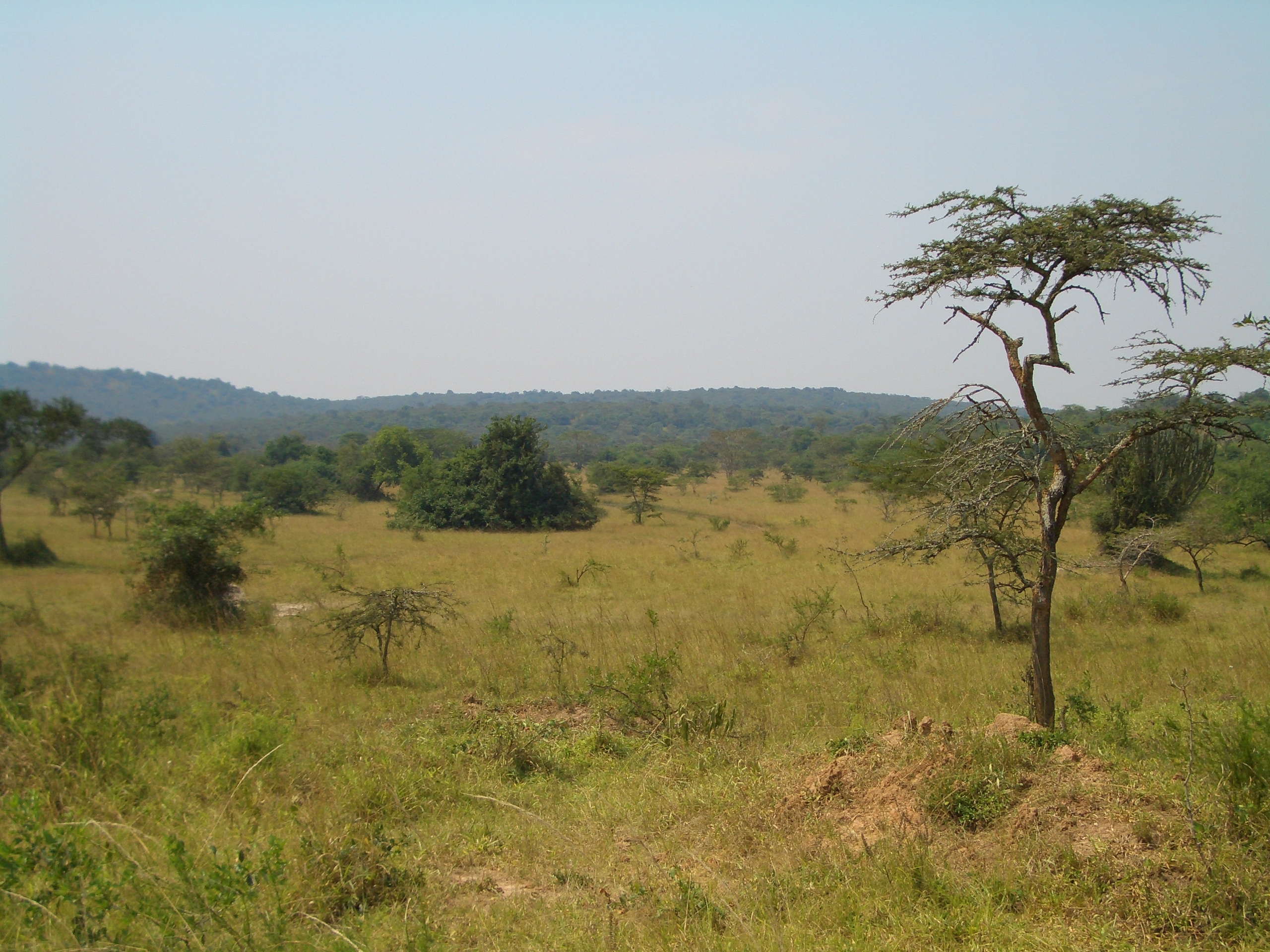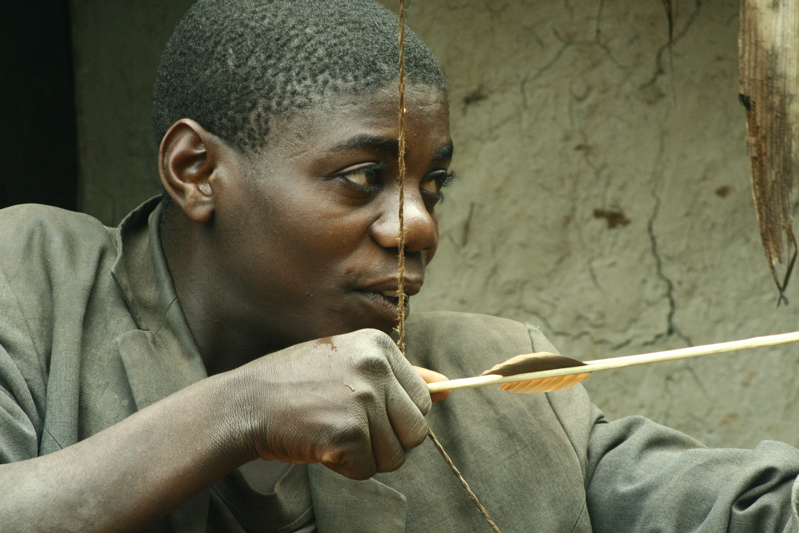|
Bwindi Impenetrable National Park
The Bwindi Impenetrable National Park (BINP) is in southwestern Uganda. The park is part of the Bwindi Impenetrable Forest and is situated along the Democratic Republic of the Congo (DRC) border next to the Virunga National Park and on the edge of the Albertine Rift. Composed of of both montane and lowland forest, it is accessible only on foot. BINP is a United Nations Educational, Scientific and Cultural Organization-designated World Heritage Site. Species diversity is a feature of the park. It provides habitat for 120 species of mammals, 348 species of birds, 220 species of butterflies, 27 species of frogs, chameleons, geckos, and many endangered species. Floristically, the park is among the most diverse forests in East Africa, with more than 1,000 flowering plant species, including 163 species of trees and 104 species of ferns. The northern (low elevation) sector has many species of Guineo-Congolian flora, including two endangered species, the brown mahogany and ''Brazzeia lo ... [...More Info...] [...Related Items...] OR: [Wikipedia] [Google] [Baidu] |
Mountain Gorilla
The mountain gorilla (''Gorilla beringei beringei'') is one of the two subspecies of the eastern gorilla. It is listed as endangered by the IUCN as of 2018. There are two populations: One is found in the Virunga volcanic mountains of Central/ East Africa, within three National Parks: Mgahinga, in southwest Uganda; Volcanoes, in northwest Rwanda; and Virunga, in the eastern Democratic Republic of Congo (DRC). The other population is found in Uganda's Bwindi Impenetrable National Park. Some primatologists speculate the Bwindi population is a separate subspecies, though no description has been finalized. As of June 2018, there were more than 1,000 individuals. Evolution, taxonomy, and classification Mountain gorillas are descendants of ancestral monkeys and apes found in Africa and Arabia during the start of the Oligocene epoch (34–24 million years ago). The fossil record provides evidence of the hominoid primates (apes) found in east Africa approximately 22–32 million ... [...More Info...] [...Related Items...] OR: [Wikipedia] [Google] [Baidu] |
Brazzeia Longipedicellata
''Brazzeia longipedicellata'' is a species of plant in the family Lecythidaceae. It is found in the Democratic Republic of the Congo and Uganda }), is a landlocked country in East Africa. The country is bordered to the east by Kenya, to the north by South Sudan, to the west by the Democratic Republic of the Congo, to the south-west by Rwanda, and to the south by Tanzania. The sou .... References Lecythidaceae Endangered plants Taxonomy articles created by Polbot {{Lecythidaceae-stub ... [...More Info...] [...Related Items...] OR: [Wikipedia] [Google] [Baidu] |
World Heritage List
A World Heritage Site is a landmark or area with legal protection by an international convention administered by the UNESCO, United Nations Educational, Scientific and Cultural Organization (UNESCO). World Heritage Sites are designated by UNESCO for having cultural, historical, scientific or other form of significance. The sites are judged to contain "cultural heritage, cultural and natural heritage, natural heritage around the world considered to be of outstanding value to Human, humanity". To be selected, a World Heritage Site must be a somehow unique landmark which is geographically and historically identifiable and has special cultural or physical significance. For example, World Heritage Sites might be ancient ruins or historical structures, buildings, cities, deserts, forests, islands, lakes, monuments, mountains, or wilderness areas. A World Heritage Site may signify a remarkable accomplishment of humanity, and serve as evidence of our intellectual history on the planet, ... [...More Info...] [...Related Items...] OR: [Wikipedia] [Google] [Baidu] |
Great Lakes Twa
The Great Lakes Twa, also known as Batwa (singular Mutwa), Abatwa or Ge-Sera, are a Bantu ethnic group native to the African Great Lakes region on the border of Central and East Africa. As an indigenous pygmy people, the Twa are generally assumed to be the oldest surviving population of the Great Lakes region. Current populations of Great Lakes Twa people live in the states of Rwanda, Burundi, Uganda and the eastern portion of the Democratic Republic of Congo. In 2000 they numbered approximately 80,000 people, making them a significant minority group in these countries. Apart from anthropological literature, the term "Twa" generally refers to the Twa of the Great Lakes region. There are a number of other Twa populations in the Congo forest, as well as southern Twa populations living in swamps and deserts where there has never been forest, but these are little known in the West. History Traditionally, the Twa have been semi-nomadic hunter-gatherers of the mountain fores ... [...More Info...] [...Related Items...] OR: [Wikipedia] [Google] [Baidu] |
Rwenzori Mountains National Park
Rwenzori Mountains National Park is a Ugandan national park and UNESCO World Heritage Site located in the Rwenzori Mountains. Almost in size, the park has Africa's third highest mountain peak and many waterfalls, lakes, and glaciers. The park is known for its beautiful plant life. History Rwenzori Mountains National Park was established in 1991. It was designated a UNESCO World Heritage Site in 1994 because of its outstanding natural beauty. Rebel militias occupied the Rwenzori Mountains from 1997 to June 2001. The park was inscribed on UNESCO's List of World Heritage in Danger between 1999 and 2004 because of insecurity and a lack of resources in the park. Geography Rwenzori Mountains National Park is located in south-western Uganda on the east side of the western (Albertine) African rift valley. It lies along Uganda's border with the Democratic Republic of the Congo (DRC) and borders the DRC's Virunga National Park, also a UNESCO World Heritage Site, for . It is situated in ... [...More Info...] [...Related Items...] OR: [Wikipedia] [Google] [Baidu] |
Mgahinga National Park
Mgahinga Gorilla National Park is a national park in southwestern Uganda. It was created in 1991 and covers an area of . Geography Mgahinga Gorilla National Park is located in the Virunga Mountains and encompasses three inactive volcanoes, namely Mount Muhabura, Mount Gahinga, and Mount Sabyinyo. In altitude the national park ranges from and is part of the Nile River watershed area. It is contiguous with Rwanda's Volcanoes National Park and the southern sector of Virunga National Park in the Democratic Republic of the Congo. The park is about by road south of the town of Kisoro and approximately by road west of Kabale, the largest city in the sub-region. Climate The area experiences two wet rainy seasons: February to May; and September to December. The average monthly rainfall varies from in October to in July. Biodiversity The national park encompasses bamboo forest, Albertine Rift montane forests, Ruwenzori-Virunga montane moorlands with tree heath, and an alpine z ... [...More Info...] [...Related Items...] OR: [Wikipedia] [Google] [Baidu] |
Bwindi Impenetrable National Park-112416
{{disambig ...
Bwindi may refer to: * Bwindi Impenetrable Forest, a primeval forest located in southwestern Uganda * Bwindi Impenetrable National Park, a park containing much of Bwindi Impenetrable Forest * Bwindi gorilla, a population of mountain gorillas found in Bwindi Impenetrable Forest * The 1999 Bwindi massacre of eight Western tourists to Bwindi Impenetrable National Park by the Army for the Liberation of Rwanda The Army for the Liberation of Rwanda (french: Armée pour la Libération du Rwanda, ALiR) was a rebel group largely composed of members of the Interahamwe and Armed Forces of Rwanda. Operating mostly in the eastern regions of the Democratic ... [...More Info...] [...Related Items...] OR: [Wikipedia] [Google] [Baidu] |
Mountain Gorilla
The mountain gorilla (''Gorilla beringei beringei'') is one of the two subspecies of the eastern gorilla. It is listed as endangered by the IUCN as of 2018. There are two populations: One is found in the Virunga volcanic mountains of Central/ East Africa, within three National Parks: Mgahinga, in southwest Uganda; Volcanoes, in northwest Rwanda; and Virunga, in the eastern Democratic Republic of Congo (DRC). The other population is found in Uganda's Bwindi Impenetrable National Park. Some primatologists speculate the Bwindi population is a separate subspecies, though no description has been finalized. As of June 2018, there were more than 1,000 individuals. Evolution, taxonomy, and classification Mountain gorillas are descendants of ancestral monkeys and apes found in Africa and Arabia during the start of the Oligocene epoch (34–24 million years ago). The fossil record provides evidence of the hominoid primates (apes) found in east Africa approximately 22–32 million ... [...More Info...] [...Related Items...] OR: [Wikipedia] [Google] [Baidu] |
Endangered Species
An endangered species is a species that is very likely to become extinct in the near future, either worldwide or in a particular political jurisdiction. Endangered species may be at risk due to factors such as habitat loss, poaching and invasive species. The International Union for Conservation of Nature (IUCN) Red List lists the global conservation status of many species, and various other agencies assess the status of species within particular areas. Many nations have laws that protect conservation-reliant species which, for example, forbid hunting, restrict land development, or create protected areas. Some endangered species are the target of extensive conservation efforts such as captive breeding and habitat restoration. Human activity is a significant cause in causing some species to become endangered. Conservation status The conservation status of a species indicates the likelihood that it will become extinct. Multiple factors are considered when assessing the ... [...More Info...] [...Related Items...] OR: [Wikipedia] [Google] [Baidu] |
Turaco
The turacos make up the bird family Musophagidae ( "banana-eaters"), which includes plantain-eaters and go-away-birds. In southern Africa both turacos and go-away-birds are commonly known as loeries. They are semi-zygodactylous: the fourth (outer) toe can be switched back and forth. The second and third toes, which always point forward, are conjoined in some species. Musophagids often have prominent crests and long tails; the turacos are noted for peculiar and unique pigments giving them their bright green and red feathers. Traditionally, this group has been allied with the cuckoos in the order Cuculiformes, but the Sibley-Ahlquist taxonomy raises this group to a full order Musophagiformes. They have been proposed to link the hoatzin to the other living birds, but this was later disputed. Recent genetic analyses have strongly supported the order ranking of Musophagiformes. Musophagidae is one of very few bird families endemic to Africa, one other being the mousebirds, ... [...More Info...] [...Related Items...] OR: [Wikipedia] [Google] [Baidu] |
Hornbill
Hornbills (Bucerotidae) are a family (biology), family of bird found in tropical and subtropical Africa, Asia and Melanesia. They are characterized by a long, down-curved bill which is frequently brightly coloured and sometimes has a Casque (anatomy), casque on the upper mandible. Both the common English (language), English and the scientific name of the family refer to the shape of the bill, "buceros" being "cow horn" in Greek language, Greek. Hornbills have a two-lobed kidney. They are the only birds in which the first and second vertebra, neck vertebrae (the atlas (anatomy), atlas and axis (anatomy), axis respectively) are fused together; this probably provides a more stable platform for carrying the bill. The family is omnivorous, feeding on fruit and small animals. They are monogamous breeders nesting in natural cavities in trees and sometimes cliffs. A number of mainly Island, insular species of hornbill with small ranges are Threatened species, threatened with extinction, ... [...More Info...] [...Related Items...] OR: [Wikipedia] [Google] [Baidu] |






